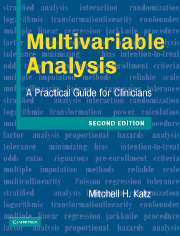Book contents
- Frontmatter
- Contents
- Preface
- 1 Introduction
- 2 Common uses of multivariable models
- 3 Outcome variables in multivariable analysis
- 4 Type of independent variables in multivariable analysis
- 5 Assumptions of multiple linear regression, multiple logistic regression, and proportional hazards analysis
- 6 Relationship of independent variables to one another
- 7 Setting up a multivariable analysis
- 8 Performing the analysis
- 9 Interpreting the analysis
- 10 Checking the assumptions of the analysis
- 11 Propensity scores
- 12 Correlated observations
- 13 Validation of models
- 14 Special topics
- 15 Publishing your study
- 16 Summary: Steps for constructing a multivariable model
- Index
2 - Common uses of multivariable models
Published online by Cambridge University Press: 05 July 2011
- Frontmatter
- Contents
- Preface
- 1 Introduction
- 2 Common uses of multivariable models
- 3 Outcome variables in multivariable analysis
- 4 Type of independent variables in multivariable analysis
- 5 Assumptions of multiple linear regression, multiple logistic regression, and proportional hazards analysis
- 6 Relationship of independent variables to one another
- 7 Setting up a multivariable analysis
- 8 Performing the analysis
- 9 Interpreting the analysis
- 10 Checking the assumptions of the analysis
- 11 Propensity scores
- 12 Correlated observations
- 13 Validation of models
- 14 Special topics
- 15 Publishing your study
- 16 Summary: Steps for constructing a multivariable model
- Index
Summary
What are the most common uses of multivariable models in clinical research?
Multivariable models have a variety of uses in clinical research, in both nonrandomized and randomized studies. The four most common uses of multivariable models are to:
A identify risk factors while adjusting for potential confounders
B adjust for differences in baseline characteristics
C determine diagnosis (diagnostic models)
D determine prognosis (prognostic models)
Models for identifying risk factors and adjusting for differences in baseline characteristics (A and B) can be thought of as explanatory or etiologic models (i.e., you are trying to explain or understand an outcome). Models for determining diagnosis and prognosis can be thought of as predictive models (i.e., you are trying to predict outcomes for patients with particular characteristics).
Identify risk factors while adjusting for potential confounders
As we learn more about certain multifactorial diseases, such as cardiac disease, we identify a larger and larger number of risk factors for the disease. Because many of these variables are associated with one another, stratification becomes an unwieldy technique for eliminating confounding. For example, when Gardner and colleagues assessed whether the size of low-density lipoprotein particles affected the incidence of coronary artery disease they adjusted their analysis for those risk factors long known to increase the risk of coronary artery disease, such as smoking, blood pressure, and body mass index. But they also adjusted their model for more recently identified risk factors such as HDL cholesterol, nonHDL cholesterol, and triglycerides.
Information
- Type
- Chapter
- Information
- Multivariable AnalysisA Practical Guide for Clinicians, pp. 14 - 23Publisher: Cambridge University PressPrint publication year: 2006
Accessibility standard: Unknown
Why this information is here
This section outlines the accessibility features of this content - including support for screen readers, full keyboard navigation and high-contrast display options. This may not be relevant for you.Accessibility Information
- 1
- Cited by
